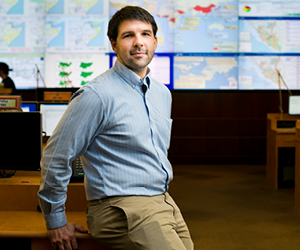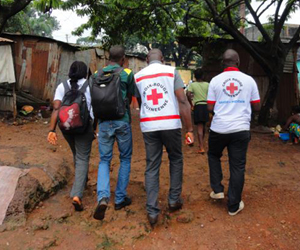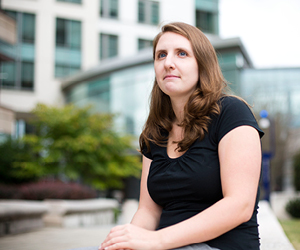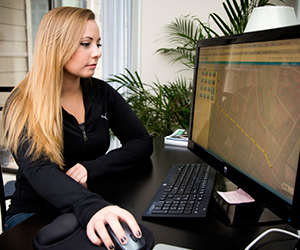Taming the Ebola epidemic
By Pam Auchmutey

Megan Klingler 14MPH (left), a Rollins graduate and registered nurse, trained health care workers on Ebola precautions and served as an isolation nurse manager for Doctors Without Borders in Nigeria. Read more about her experience at bit.ly/megan-klingler-RSPH.
|
|
Preparedness was the operative word when Emory University Hospital successfully treated the first two patients with the Ebola virus in the United States. In August, the hospital admitted Kent Brantly and Nancy Writebol, who became infected while working as missionaries in Liberia. A month later, a third American arrived from Sierra Leone and was admitted, followed by a nurse from Dallas, Texas, in October.
Even before Brantly and then Writebol arrived in Atlanta by air ambulance, the eyes of the world focused on the physicians and nurses who did not blink when asked to care for the aid workers.
"We are ready," Jay Varkey, one of the physicians in the Serious Communicable Disease Unit at Emory Hospital, told a reporter with the Los Angeles Times.
Bruce Ribner, the physician in charge of the unit, responded without hesitation when approached about treating Brantly, who worked for Samaritan's Purse in Liberia. "We've been practicing for this for 12 years," Ribner told the U.S. State Department.
The Ebola patients in the isolation unit received round-the-clock supportive care to maintain vital functions to enable the body's immune system to fight the virus and recover. As Ribner's team quickly learned, replacing fluids and electrolytes lost primarily through vomiting and diarrhea was key to their patients' recovery.
"We depend on the patient's body defenses to control the virus," Ribner explains. "We have to keep the patient alive long enough for the body to control the infection."
In preparation for their first patients, Emory physicians and nurses practiced donning and doffing the protective suits, gloves, booties, and hoods required to keep them safe while working in the isolation unit. Sean Kaufman, a biosafety expert and former faculty member at the RSPH, coached team members on how to suit up and remained on hand to ensure they followed procedures, including when the staff had to contain a small spill of contaminated fluids.
|
|
Kaufman has taught biosafety all over the world and led training programs for Rollins' Center for Public Health Preparedness and Research, established after 9/11 with a gift from the O. Wayne Rollins Foundation. "We made sure everything was by the book," says Kaufman, who observed the Emory team's patient interactions from the anteroom in the isolation unit.
The battle in West Africa
The same strict protocol holds true for public health experts deployed by the CDC and other agencies to contain the virus in West Africa. "That requires old-fashioned public health practices—identification, isolation, contact tracing, more isolation, and watching contacts for symptoms," says Jeffrey Koplan, vice president for global health at Emory and former director of the CDC. "You can't miss anybody—85% is not enough, 'most' is not enough."
More than 20 outbreaks of Ebola hemorrhagic fever have occurred in Africa since 1976, when the disease was first detected near the Ebola River in the Democratic Republic of Congo (then called Zaire) and Sudan. Most outbreaks have been relatively small until now. The latest outbreak, centered in Guinea, Liberia, and Sierra Leone in West Africa, began in December 2013 and was first detected in southern Guinea in March 2014.
That same month, the CDC's Pierre Rollin left for Guinea a few days after giving a lecture in Carlos del Rio's course on International Infectious Diseases at the RSPH. Rollin is regarded as the world's leading expert on viral hemorrhagic fevers like Ebola.
"Clearly, RSPH students have heard from the very best in the field about this topic," says del Rio, Hubert Professor and chair of the Hubert Department of Global Health.
During two deployments to Guinea, Rollin led CDC efforts to collect and manage data, follow up confirmed cases, provide health communication and information, and train physicians and health workers in collaboration with the nation's Ministry of Health. The challenges proved daunting.
"People and officials in Guinea were very afraid because it was the first time that Ebola struck in West Africa, and they had a lot of questions about the disease and transmission," Rollin says. "They are now better informed, though some still don't believe that this is a disease."
"Obviously, you cannot fix everything in the middle of the outbreak," he adds. "People's behaviors and responses to disease are influenced by their traditions, and that is very difficult to change. I've learned to work with religious leaders to try to influence the population."
Back in the United States, Emory physicians advised that doctors in hospitals and emergency rooms worldwide be ready to recognize Ebola virus infection and isolate patients if necessary. And while the physicians noted that concerns about the virus spreading beyond West Africa to Europe and North America were valid, they emphasized that Ebola was transmitted only through direct contact with bodily fluids (not through the air like influenza) and that highly developed hospital infection control practices would contain the virus.
|
|
"The main lesson we have learned from the current Ebola outbreak is that we can no longer ignore global disparities in health care resources," says del Rio, who co-wrote an article about the epidemic with Aneesh Mehta and Marshall Lyon, physicians on the isolation unit at Emory Hospital, and Emory pathologist Jeannette Guarner for the Annals of Internal Medicine. "The affected countries have some of the most dire health care infrastructures with a paucity of health care providers. The other lesson is that sound public health, engagement with affected communities, and international solidarity are needed to control this outbreak."
Since the number of Ebola cases escalated in early August, more than 850 CDC staff members have been called on to work in the agency's Emergency Operations Center (EOC). An additional 100 CDC experts are being deployed for weeks at a time to West Africa, along with members of the U.S. military pledged by President Obama during his visit to the CDC in September. CDC epidemiologist Jeffrey Ratto 10MPH worked with the District Health Management Team in Port Loko, Sierra Leone, to conduct surveillance, including tracking cases and contacts of cases.
"There are many challenges to containing the Ebola outbreak in Sierra Leone," Ratto wrote while stationed in the country. "Community belief has a huge impact on our control efforts. As long as people don't believe in the disease or don't change their behavior, the surveillance efforts won't stop it. A single unsafe funeral can infect many people and start a transmission chain in the community that goes through multiple people. Traditional practices in conducting funerals have persisted throughout the outbreak."
At the CDC in Atlanta, Lisandro Torre 02OX 04C 12MPH works in the EOC with the Medical Supply Task Force to provide estimates for the number and cost of supplies needed to combat the outbreak. Supplies range from hospital beds and facilities to personal protection equipment for health care workers. Like his colleagues, Torre sees West Africa's poor health infrastructure as the greatest challenge in combatting the disease.
"The shortage of health facilities and trained health care providers makes it difficult to reach the level of infection control needed to curb the outbreak," he says. "We are simultaneously combatting the disease and trying to assist governments in building up their infrastructure. There has been some progress, but the undertaking is so large that the progress made seems to be overtaken by the disease. Our goal is to reverse that.
"I'm doing a lot of things in this response that I would not have expected coming out of Rollins," he continues. "Everyone I've met during the response has been willing to do anything to push the mission forward, regardless of what their job title says they're supposed to be doing. You need to make yourself match the needs and not wait for the role you think you fit in."
Science and compassion
Mary Claire Worrell, a second-year student in global epidemiology at Rollins, first learned of the Ebola outbreak last March through emails posted on the website ProMED.
Her interests in infectious disease and emergency response led her to enroll last year in the Complex Humanitarian Emergencies Certificate Program offered through the Center for Humanitarian Emergencies (CHE) at Rollins. The center, a collaborative effort of the school and the Emergency Response and Recovery Branch at the CDC, also provides an annual fellowship to a student from a conflict-affected country and supports practicum experiences for students in the certificate program.
This year, CHE director Dabney Evans 98MPH has added teaching and research to the center's activities. Several MPH students are helping her teach an undergraduate course on complex humanitarian emergencies. Additionally, a CHE research team comprised of 17 MPH students is working on a variety of projects related to humanitarian emergencies in various countries.
In her CHE courses, Worrell listens to lectures by experts at the CDC, including Mark Anderson, acting chief of the Emergency Response and Recovery Branch. Anderson has taught classes at Rollins for nearly a decade, and his branch provides funding support for the CHE. Last year, Anderson helped orchestrate responses to humanitarian crises in Syria, Ethiopia, South Sudan, and the Central African Republic. In recent months, he has worked in the EOC to assist with the Ebola outbreak.
"That's the great thing about our CHE courses," says Worrell. "They are taught by people who know everything because they work on the ground. It's an amazing opportunity. The response to Ebola permeates into the Rollins community because of our proximity to the CDC."
Next spring, Pierre Rollin will lecture again in Carlos del Rio's course on International Infectious Diseases. He'll have much to share about the Ebola epidemic, which experts predict will last for several more months and possibly cause up to 1 million cases in West Africa. What might he tell students then?
"The most important thing is to realize that you always have something to learn," writes Rollin from Guinea. "Common sense and compassion are the best tools when you don't know something. Science is important. But being a good public health practitioner includes a little bit of anthropology, communication skills, practical skills, and a lot of humility."
|
Learn more about the Ebola epidemic in the article co-written by Carlos del Rio for the Annals of Internal Medicine at bit.ly/Ebola-annals. The website also includes a video of del Rio discussing the topic. |
Mapping the Way
SORT students aid Ebola response in West Africa
One of the main challenges in responding to the Ebola epidemic in West Africa is difficulty in finding people who live in remote areas. Existing maps pinpointing the location of villages, houses, buildings, ponds, paths, and roads are either out of date or do not exist at all. The Student Outbreak and Response Team (SORT) at Rollins, which partners with the CDC and others to provide hands-on training and experience in outbreak response and emergency preparedness, is helping remedy that.
|
|
SORT members, 45 in all, are part of a global volunteer army helping map small squares of land throughout the affected West African region in more detail. All it takes is a computer, an Internet connection, and a couple of hours of training led by Ryan Lash, a geographer in the Division of Global Migration and Quarantine in the Travelers' Health Branch at the CDC.
In August, as the number of Ebola cases surged, Lash contacted SORT to ask the students for help. He taught them how to use an online mapping platform called OpenStreetMap to gather spatial data, particularly in Guinea, Sierra Leone, and Liberia. Students use a base map generated by aerial satellite imagery and proceed to identify villages, houses, buildings, and other details based on that imagery. A system of checks and balances is in place to ensure that the new detailed map is accurate.
"It's like the Wikipedia of mapping," says Anna Tate, a second-year MPH student and communications chair with SORT. "OpenStreetMap allows volunteers to provide more detailed maps to organizations on the ground like Doctors Without Borders that are spearheading the Ebola response."
Tate is also a fellow in the CDC's Office of Public Health Preparedness and Response. The Ebola outbreak afforded her the opportunity to be part of high-level meetings in the Emergency Operations Center and to update CDC statistics on the number of Ebola cases and deaths in each African country. She publishes the new numbers online every few days, based on the latest statistics from the World Health Organization.
Her current work on Ebola is a fitting extension of her interest in viral hemorrhagic fevers. The subject captivated her in high school when she read The Hot Zone: A Terrifying True Story, the 1994 bestseller about the origins of such diseases.
"I feel very fortunate to work on the Ebola response at the CDC and with SORT," says Tate. "I had no idea I would be involved in such an unprecedented international outbreak response. It's a rare and incredibly rewarding opportunity."—Pam Auchmutey




